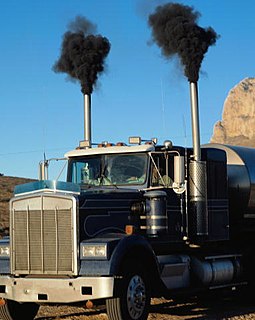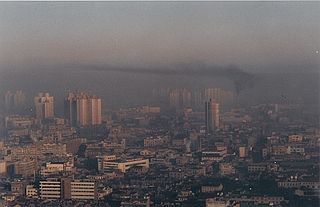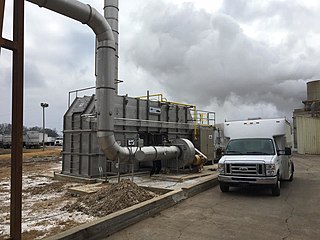
A pollutant is a substance or energy introduced into the environment that has undesired effects, or adversely affects the usefulness of a resource. A pollutant may cause long- or short-term damage by changing the growth rate of plant or animal species, or by interfering with human amenities, comfort, health, or property values. Some pollutants are biodegradable and therefore will not persist in the environment in the long term. However, the degradation products of some pollutants are themselves polluting such as the products DDE and DDD produced from degradation of DDT.

Smog is a type of severe air pollution. The word "smog" was coined in the early 20th century as a blending of the words smoke and fog to refer to smoky fog, its opacity, and odor. The word was then intended to refer to what was sometimes known as pea soup fog, a familiar and serious problem in London from the 19th century to the mid-20th century. This kind of visible air pollution is composed of nitrogen oxides, sulphur oxides, ozone, smoke and other particulates. Man-made smog is derived from coal combustion emissions, vehicular emissions, industrial emissions, forest and agricultural fires and photochemical reactions of these emissions.

Ozone (O3) is a trace gas of the troposphere, with an average concentration of 20-30 parts per billion by volume (ppbv), with close to 100 ppbv in polluted areas. Ozone is also an important constituent of the stratosphere, where the ozone layer exists. The troposphere is the lowest layer of the Earth's atmosphere. It extends from the ground up to a variable height of approximately 14 kilometers above sea level. Ozone is least concentrated in the ground layer (or planetary boundary layer) of the troposphere. It's concentration increases as height above sea level increases, with a maximum concentration at the tropopause. About 90% of total ozone in the atmosphere is in the stratosphere, and 10% is in the troposphere. Although tropospheric ozone is less concentrated than stratospheric ozone, it is of concern because of its health effects. Ozone in the troposphere is considered a greenhouse gas, and may contribute to global warming.

Indoor air quality (IAQ) is the air quality within and around buildings and structures. IAQ is known to affect the health, comfort and well-being of building occupants. Poor indoor air quality has been linked to Sick Building Syndrome, reduced productivity and impaired learning in schools.

Commuting is periodically recurring travel between one's place of residence and place of work, or study, and in doing so exceed the boundary of their residential community. It sometimes refers to any regular or often repeated traveling between locations, even when not work-related. A distinction is also often made between commuters who commute daily or weekly between their residence to work place, often being suburbs to cities, and are therefore considered respectively local or long-distance commuters.

Exhaust gas or flue gas is emitted as a result of the combustion of fuels such as natural gas, gasoline, petrol, biodiesel blends, diesel fuel, fuel oil, or coal. According to the type of engine, it is discharged into the atmosphere through an exhaust pipe, flue gas stack, or propelling nozzle. It often disperses downwind in a pattern called an exhaust plume.

Air pollution is a concern in British Columbia, Canada because of its effects on health and visibility. Air quality is influenced in British Columbia (BC) by numerous mountain ranges and valleys, which complicate atmospheric pollution dispersion and can lead to high concentrations of pollutants such as particulate matter from wood smoke.
The National Emissions Standards Act, officially known as the Motor Vehicle Air Pollution Control Act, is a 1965 amendment to the U.S. Clean Air Act of 1963. The amendment set the first federal vehicle emissions standards, beginning with the 1968 models. These standards were reductions from the 1963 emissions: 72% reduction for hydrocarbons, 56% reduction for carbon monoxide, and 100% reduction for crankcase hydrocarbons. The impact the regulatory standards will have on air quality in the future, as well as the potential characteristics of the vehicle fleet can be analyzed with the use of roadway air dispersion models.

An air quality index (AQI) is used by government agencies to communicate to the public how polluted the air currently is or how polluted it is forecast to become. As the AQI increases, an increasingly large percentage of the population is likely to experience increasingly severe adverse health effects. Different countries have their own air quality indices, corresponding to different national air quality standards. Some of these are the Air Quality Health Index (Canada), the Air Pollution Index (Malaysia), and the Pollutant Standards Index (Singapore).
In atmospheric chemistry, NOx is a generic term for the nitrogen oxides that are most relevant for air pollution, namely nitric oxide (NO) and nitrogen dioxide (NO2). These gases contribute to the formation of smog and acid rain, as well as affecting tropospheric ozone.

Spare the Air is a program established by the Bay Area Air Quality Management District in 1991 to combat air pollution during the summer in the San Francisco Bay Area, the season when clear skies, hot temperatures, lighter winds, and a strong temperature inversion combine and trap air pollutants near the ground.
Criteria air Pollutants (CAP), or criteria pollutants, are a set of air pollutants that cause smog, acid rain, and other health hazards. CAPs are typically emitted from many sources in industry, mining, transportation, electricity generation and agriculture. In many cases they are the products of the combustion of fossil fuels or industrial processes.

Air pollution occurs when harmful or excessive quantities of substances including gases, particles, and biological molecules are introduced into Earth's atmosphere. It may cause diseases, allergies and even death to humans; it may also cause harm to other living organisms such as animals and food crops, and may damage the natural or built environment. Both human activity and natural processes can generate air pollution.
An Ozone Action Day, which can be declared by a local municipality, country or state, is observed at certain times during the summer months, when weather conditions run the risk of causing health problems.

The Clean Air Act is a United States federal law designed to control air pollution on a national level. It is one of the United States' first and most influential modern environmental laws, and one of the most comprehensive air quality laws in the world. As with many other major U.S. federal environmental statutes, it is administered by the U.S. Environmental Protection Agency (EPA), in coordination with state, local, and tribal governments. Its implementing regulations are codified at 40 C.F.R. Sub-chapter C, Parts 50-97.

Air quality laws govern the emission of air pollutants into the atmosphere. A specialized subset of air quality laws regulate the quality of air inside buildings. Air quality laws are often designed specifically to protect human health by limiting or eliminating airborne pollutant concentrations. Other initiatives are designed to address broader ecological problems, such as limitations on chemicals that affect the ozone layer, and emissions trading programs to address acid rain or climate change. Regulatory efforts include identifying and categorizing air pollutants, setting limits on acceptable emissions levels, and dictating necessary or appropriate mitigation technologies.

Air pollution in the United Kingdom has long been considered a significant health issue. Many areas, including major cities like London are found to be significantly and regularly above legal and recommended levels. Air pollution in the UK is a major cause of diseases such as asthma, lung disease, stroke, and heart disease, and is estimated to cause forty thousand premature deaths each year, which is about 8.3% of deaths, while costing around £40 billion each year.

The 1966 New York City smog was an air-pollution event, with damaging levels of carbon monoxide, sulfur dioxide, smoke, and haze. Smog covered the city from November 23 to 26, which was that year's Thanksgiving holiday weekend. It was the third major smog in New York City, following events of similar scale in 1953 and 1963.
Environmental issues in Toronto encompasses all those concerns and opportunities presented by the environment of Toronto. Many are harmful effects, such as the pollution of air and water, while others are factors influenced by urban infrastructures such as highways and public transportation services. As a result of the city's large population, substantial waste is produced annually.















